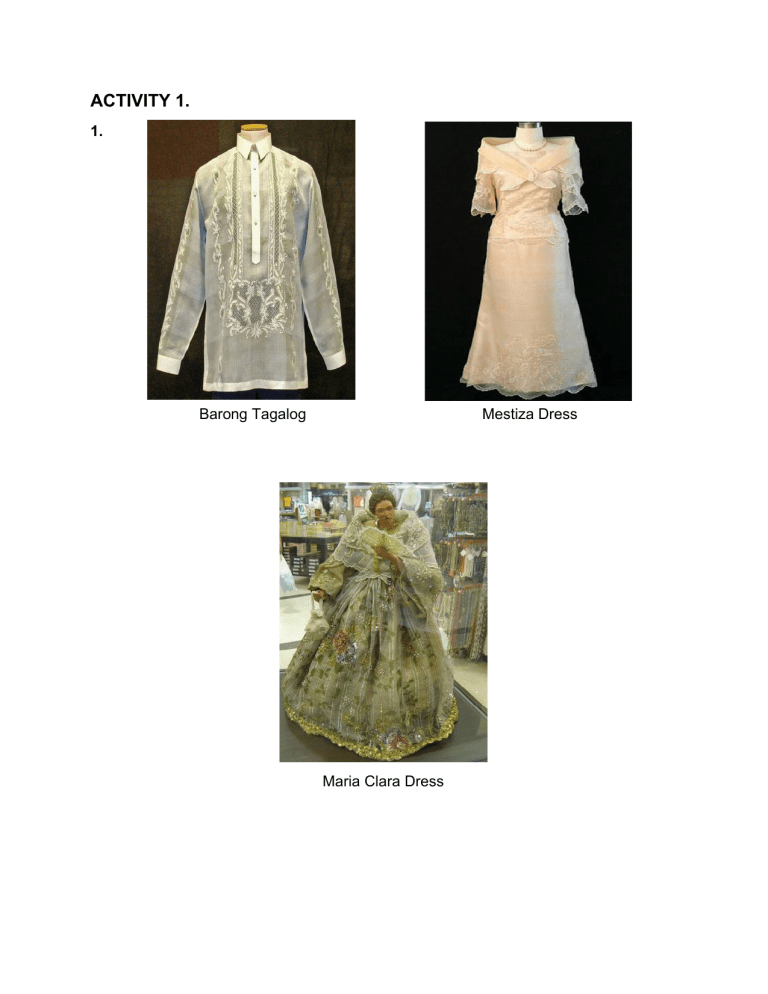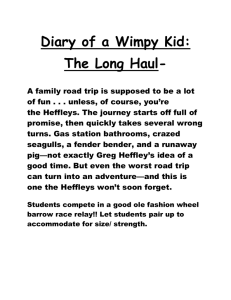
ACTIVITY 1. 1. Barong Tagalog Mestiza Dress Maria Clara Dress 2. Barong Tagalog is the official national costume of Filipino men, originated from the northern part of the Philippines, and is originally made of jusi or pineapple cloth called “pina” (woven from pineapple leaves). It is worn over a Chinese collarless shirt called camisa de Chino. It exhibits the loose, long lines of its Chinese sources, the airy tropical appearance of Indo-Malay costume, the elongated effect of Hindu dressing, and the ornamental restraint of European men's clothing. It is usually used for formal occasions. The Mestiza Dress is a formal dress made of expensive lace and fabric adorned with embroideries. It is the sophisticated version of the national costume, the baro't saya (blouse and skirt). Made more popular by former Philippine First Lady Imelda Marcos, some even called it Imelda dress or terno. Mestiza dress is known for its elegance and butterfly sleeves. It is usually worn for formal occasions. Maria Clara's dress was named after a mestiza heroine of one of the novels of the Philippine National hero Dr. Jose Rizal. Its origin was the national costume of Filipino women which is baro't (shirt) saya (skirt). The Maria Clara gown features a floor-length paneled skirt of silk or satin and it consists of four separate pieces: the collarless waist-length, bell sleeved camisa; the bubble-shaped, floor-length saya; the stiff, neck-covering pañuelo; and the hip-hugging, knee length tapis, or overskirt. Before, it was used by women in a day-to-day basis. 3. Truthfully, it is authentic, colorful, and powerful to the extent that it carries the essence of occupation. At a glance, since they are costumes of a dance depicting actions of occupations. One could say that the costumes are too simple, colorful, and detailed; depending on the occupational dance. Yet, if one looks more closely. Its simplicity is subdued for the purpose of centering the attention to the dance. The nature of occupations before and how noble they are. Second, it is colorful and detailed because these are costumes worn by the workers themselves. Its complexity is somehow influenced by foreign cultures. However, the central message or purpose of each dance is always explicitly seen in the costumes. 4. Seagulls just like other birds, fly from one place to another and land in seashores. However, what differentiates them from other birds are their seemingly peculiar movements that is similar to dancing. They can be observed dancing and stamping their feet on grassy areas by raising and lowering each foot in turn. The movement of their feet on the grass causes vibrations which are similar to that created by rain. In Samar, these movements gave birth to Lapay Bantigue. Where the first step is “lupad” where arms fluttered in a graceful fashion as in flapping of wings. Then the “kumintang” which entails rotating of hands and wrist while turning and twirling. Next is the “tuka” which is a pecking motion with back bent moving forward and backward. Other steps required moving sideways, forward and backward, stomping, jumping and gliding. 5. Mimicking is simply copying or imitating something. In this case, Lapay Bantigue Dance was created because of imitating the graceful movement of seagulls. Villagers of Bantigue imitated their flight, swoops, dives, and glides. Due to these playful versions of people, it became steps and so named the Lapay Bantigue Dance. 6. • • • • • • • • • • • Seagulls are very clever. They learn, remember and even pass on behaviors, such as stamping their feet in a group to imitate rainfall and trick earthworms to come to the surface. Seagulls’ intelligence is clearly demonstrated by a range of different feeding behaviors, such as dropping hard-shelled mollusks onto rocks so that they break open so they can eat them, and following ploughs in fields where they know upturned grubs and other food sources will be plentiful. Seagulls are attentive and caring parents. The male and female pair for life and they take turns incubating the eggs, and feeding and protecting the chicks. Gulls have a complex and highly developed repertoire for communication which includes a range of vocalizations and body movements. Seagulls can drink both fresh and salt water. Most animals are unable to do this, but seagulls have a special pair of glands right above their eyes which is specifically designed to flush the salt from their systems through openings in the bill. There is a great deal of diversity between different gull species, with the smallest being the Little Gull (120 g and 29 cm) and the largest being the Great Blackbeaked Gull (1.75 kg and 75 cm). A small claw halfway up their lower leg enables them to sit and roost on high ledges without being blown off. Young gulls form nursery flocks where they will play and learn vital skills for adulthood. Nursery flocks are watched over by a few adult males and these flocks will remain together until the birds are old enough to breed. In Native American symbolism, the seagull represents a carefree attitude, versatility, and freedom. Many seagulls have learned to conserve energy by hovering over bridges in order to absorb raising heat from paved roadways. Seagulls are fondly remembered in Utah for helping Mormon settlers deal with a plague of crickets. The seagull is now the state bird of Utah and a monument in Salt Lake City commemorates the event, known as the ‘Miracle of the Gulls’. 7. It is a flock of seagulls obviously in the sea. It looks like it is mating season for them. However, one fact that cannot be forgotten is that because of these seagulls’ movements, Lapay Bantigue Dance is created.




